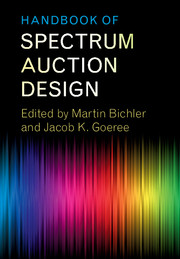Book contents
- Frontmatter
- Contents
- List of Contributors
- Preface
- List of Papers
- Part I The Simultaneous Multiple-Round Auction
- Part II The Combinatorial Clock Auction Designs
- Part III Alternative Auction Designs
- Part IV Experimental Comparisons of Auction Designs
- Part V The Bidders’ Perspective
- 31 Winning Play in Spectrum Auctions
- 32 Up in the Air: GTE's Experience in the MTA Auction for Personal Communication Services Licenses
- 33 Bidding Complexities in the Combinatorial Clock Auction
- 34 Strategic Bidding in Combinatorial Clock Auctions – A Bidder Perspective
- 35 Impact of Budget Constraints on the Efficiency of Multi-lot Spectrum Auctions
- Part VI Secondary Markets and Exchanges
- Outlook
- References
32 - Up in the Air: GTE's Experience in the MTA Auction for Personal Communication Services Licenses
from Part V - The Bidders’ Perspective
Published online by Cambridge University Press: 26 October 2017
- Frontmatter
- Contents
- List of Contributors
- Preface
- List of Papers
- Part I The Simultaneous Multiple-Round Auction
- Part II The Combinatorial Clock Auction Designs
- Part III Alternative Auction Designs
- Part IV Experimental Comparisons of Auction Designs
- Part V The Bidders’ Perspective
- 31 Winning Play in Spectrum Auctions
- 32 Up in the Air: GTE's Experience in the MTA Auction for Personal Communication Services Licenses
- 33 Bidding Complexities in the Combinatorial Clock Auction
- 34 Strategic Bidding in Combinatorial Clock Auctions – A Bidder Perspective
- 35 Impact of Budget Constraints on the Efficiency of Multi-lot Spectrum Auctions
- Part VI Secondary Markets and Exchanges
- Outlook
- References
Summary
Introduction
In a series of auctions starting in 1994, the Federal Communications Commission (FCC) sold the rights to provide personal communications services (PCS) using the electromagnetic spectrum. The rights are defined by both wavelength and geographic coverage. The largest of these auctions, for ninety-nine 30-MHz licenses in 51 major trading areas (MTAs) in the United States and its territories (two per MTA, except one each in New York, Los Angeles, and Washington, DC) began on December 5, 1994. Thirty bidders registered and qualified for the auction and spent over $7 billion acquiring licenses. This report describes how our team (for GTE) answered the following question: Given the information we had about GTE's valuations, budgets and objectives, the valuations, budgets and objectives of rival bidders, and the rules, how should we bid to achieve the best attainable outcome?
In developing our auction strategy we relied on (1) our knowledge of the other bidders and market opportunities, (2) our understanding of GTE's senior management's objectives, and (3) the ability to adapt game theory to model the behavior of bidders in the auction. Going into the auction, GTE's senior management gave our bidding team an outline of the company's objectives. Because we had limited information about our rivals, we needed to make some guesses about their interests, valuations, and budgets, as well as about the auction's duration and the price threshold.
The FCC used a novel simultaneous, multiple-round ascending-bid SMR format for this auction (see Cramton (1995a) or McAfee and McMillan (1995) for a more detailed description). In summary, 30 firms simultaneously bid on 99 PCS licenses in a sequence of rounds. At the end of each round, the FCC posted all the bids from that round, and the bidders then had the chance to place new bids in the next round (subject to constraints imposed by the activity rules). The auction rules specified that the auction would close on all 99 properties at the same time.
- Type
- Chapter
- Information
- Handbook of Spectrum Auction Design , pp. 713 - 730Publisher: Cambridge University PressPrint publication year: 2017



